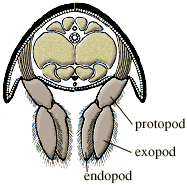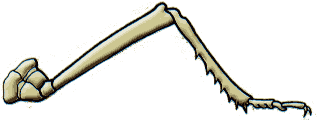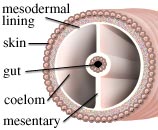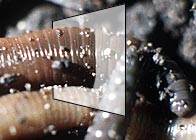| Acoela("not"
"hollow"): |
an Order of marine turbellarian flatworms characterized by
absence of gut and excretory organs. The name refers to the absence of
a gut and NOT to the absence of a coelom, even though they are also
acoelomate in that they do lack a coelom (see next entry)
|
| Acoelomate ("not"
"coelom"): |
refers to the condition, as seen in flatworms, in which a
coelom is absent. The term is applied to triploblasts and not to diploblasts
(cnidarians), even though the latter are also "acoelomate". The
reason for this is that owing to the lack of mesoderm in diploblasts, a
coelom is not possible |
| Acontium
("javelin or dart"): |
tubular extensions off the ventral edges of the internal
mesenteries in sea anemones which are well-endowed with nematocysts and
which function to tangle and disable ingested prey. The acontia generally
reside in the gastrovascular cavity but, in some species, they can be protruded
out of holes in the body column where they act in defense |
| Adaptive radiation:
|
refers to the evolutionary spread of different species (from a single common ancestor) into different
habitats. Animals most successful at this have been arthropods (especially
insects), gastropods, and nematodes |
| Alternation of generation:
|
a term sometimes used to describe the alternation of sexual
(medusa) and asexual (polyp) stages in cnidarians such as hydroids and jellyfish.
It is not a useful term for cnidarians because, unlike in mosses and ferns
where the expression originated, the two stages in cnidarians often occur
simultaneously |
| Ambulacral groove
("ambulare": to walk): |
a groove running down the oral surface of an echinoderm arm,
containing the tube feet |
| Ammonia |
a metabolic waste product resulting from the deamination
of amino acids. Ammonia is highly toxic and must be eliminated. It is highly
soluble in water (as ammonium ion) and highly diffusible; hence, is the
commonest form of nitrogenous excretion in aquatic animals |
| Amoebocyte
("amoibe": change; "kyto": cell): |
in a sponge is a type of cell which functions in food transport
and storage, and in riddance of solid wastes. Amoebocytes have the ability
to transform into all other cell types of the sponge. Specialized amoebocytes
contain pigments and impart colours to sponges |
| Amphiblastula
("amphi": on either side): |
A specialized larval stage of calcareous sponges (Cl. Calcarea)
consisting of a hollow ball of cells, half of which are small flagellated
cells for locomotion, the other half, larger cells. After a short free-living
life in the sea, the larva settles to the bottom and undergoes cellular
movements which lead to the creation of an inner lining of flagellated cells
(choanocytes) covered by a protective layer of pinacocyte cells.
Note that there is no gastrulation, a feature which separates sponges
from all other animals.
View Amphiblastula Animation
|
| Analogous:
|
similar in function or appearance but not in origin. Thus,
Malpighian tubules of insects and green glands of crustaceans are analogous
in that both are involved in excretion, but have evolved differently; hence,
are not homologous |
| Annelida
("ring"): |
a Phylum of segmented worms including tubeworms, sandworms,
earthworms, and leeches |
| Anthozoa
("flower" "animal"): |
a Class of Phylum Cnidiaria which includes sea anemones,
corals, and gorgonians |
| Aposematic ("away"
"signal"): |
colours, smells, or structures on or from an organism that
act as defensive signals. They convey to a potential predator the message
that the organism is unpalatable. Colours are usually bright, and their
pattern, hue, and intensity may be specially "tailored" to the
sensory capabilities of the predator. An example is the bright orange and
black colouration on milkweed bugs which are toxic to bird and other predators
owing to the sequestration of toxins from their diet |
| Apterygote ("without"
"wings" "gotta"): |
name given to the type of development exhibited by primitive
wingless insects such as collembolids (Order Collembola). Development in
apterygotes involves a series of instars (moult stages) which are
similar in body proportions but differ in size (thus, young stages are perfect
miniatures of older stages). Contrast with exopterygota and endopterygota
|
| Aquiferous system
("aqua": water): |
describes the system unique to sponges in which water flows
through canals and chambers, pumped by choanocytes |
| Archenteron
("ancient" "gut"): |
formed during gastrulation and open to the external
environment, this is the tube that runs through the developing embryo. It
consists of endoderm and will develop into the digestive system of the organism.
Because it is topographically outside of the body, it is not considered
to be a "body cavity" as such. The term "body cavity"
should be restricted to the blastocoel and its derivatives (pseudocoel,
hemocoel, and coelom) |
| Archeocyte
("ancient" "cell"): |
in a sponge refers to a type of cell that can differentiate
into all other types. A specific example is the modified amoebocyte that
is contained in a gemmule and which, on hatching, can form all the diverse
cell types in the new sponge. In a general sense, amoebocytes can also be
called archeocytes, becauses they can differentiate into all other cell
types in the sponge |
| Archeogastropoda
("ancient" "gastropod"): |
an Order of the SubClass Prosobranchia in Class Gastropoda
including the limpets and abalone. These are among the most plesimorphic
gastropods |
| Arthropoda ("jointed"
"foot): |
a Phylum including horseshoe crabs, insects, millipedes,
centipedes, mites, spiders, ticks, and crabs |
| Ascon or
asconid or asconoid:
|
the simplest (and most primitive) form of sponges, consisting
of a vase-shape with the inner chamber, or spongocoel, being lined
by choanocytes or feeding cells |
| Ascidiacea
("little bag" "characterized by"): |
a Class of the SubPhylum Urochordata of Phylum Chordata which
includes the sea squirts |
| Asteroidea
("star"): |
a Class of Echinodermata which includes the seastars |
| Batesian mimicry:
|
a type of mimicry in which otherwise palatable insects evolve
colour patterns and/or shape and/or behaviour which mimic a toxic unpalatable
form. The mimic thus gains a secondarily-derived immunity from the predator.
Batesian mimicry is found mainly in lepidopterans (butterflies, moths),
dipterans (flies), and hymenopterans (bees, ants), but may also be found
(rarely) in other invertebrates. Contrast with Mullerian mimicry
|
| Benthic ("benthos":
deep): |
refers to organisms that live on the bottom of any body of
water. Epibenthic describes organisms that live just above the
bottom |
| Bilateral symmetry: |
see Symmetry |
| Biogenetic law
("bios": life; "genetikos": origin): |
an idea that "ontogeny recapitulates phylogeny",
or that embryology or early development of an organism repeats the evolutionary
history that gave rise to the organism. Torsion was thought by
Walter Garstang (evolutionist, poet) to be a kind of flashback or speeded-up
repeat of what may have occurred in gastropod evolution to bring the posterior-facing
mantle cavity to the front of the animal |
| Bipolar ("two"
"pole or end"): er direction |
when referring to the nerve cells of triploblastic animals
the term indicates that the neurones have different ends (axon and dendrite)
and passage of action potentials is in one direction only. Contrast with certain
neurones of (diploblastic) cnidarians which are apolar, in which action potentials
can pass in either direction |
| Biradial symmetry: |
see Symmetry |
| Biramous ("two"
"branch"): |
an appendage-type in crustaceans consisting of a basal portion with two
separate branches. Because this type of appendage is present in primitive
present-day crustaceans, it is believed to represent the form of ancestral
appendage from which all other specialized appendage types evolved in
crustaceans. In advanced crustaceans, such as crayfish or crabs, the appendage-type
most closely resembling this ancestral form is the pleopod or swimmeret
on the abdomen.
2 views: one of uniramous appendage, one of biramous
 |
cross-section through abdomen of lobster to show
biramous pleopods (swimmerettes). |

uniramous insect leg
|
| Bivalvia ("two"
"valves"): |
a Class of Phylum Mollusca which includes clams, mussels,
oysters, and scallops. The protective shell is in two parts |
| Blastocoel
("bud" "hollow"): |
a cavity within the blastula. Following gastrulation,
the blastocoel may remain fluid-filled but otherwise undifferentiated (nematodes
and rotifers), become filled with a proteinaceous gelatinous matrix (poriferans
and cnidarians), become filled with a solid cell mass known as mesenchyme
(platyhelminthes and nemertines), or become lined with mesoderm to
form a cavity known as the coelom. (the coelom may be fluid-filled
as in annelids and echinoderms, or just be a space as in vertebrates). See
gastrulation. |
| Blastopore
("bud" "opening"): |
an opening into the primitive gut (archenteron)
of the gastrula which will later become the mouth in Protostomes
and the anus in Deuterostomes |
| Blastula
("bud" "little"): |
a developmental stage in animals occurring at about the 128-512
cell stage (7th-9th division). The blastula consists
of one layer of cells and, where little yolk is present, is hollow (the
cavity is the blastocoel). It usually is characterized by having
a hemisphere of small cells (micromeres) and a hemisphere of large
cells (macromeres). The blastual stage is reached a few hours or
a day following fertilization and in all animals save sponges develops into
the the gastrula (see gastrulation)
|
| Blind gut:
|
describes a situation, as found in cnidarians (sea jellies,
sea anemones) and platyhelminthes (flatworms) where there is one opening only
into the gut. Thus, the mouth functions for both ingestion and egestion |
| Body cavity:
|
generally refers to cavities which are remnants of the embryological
blastocoel, such as pseudocoels, hemocoels, or coeloms,
but sometimes refers (in the absence of the above) to the gastrovascular
cavity or gut of cnidarians. In triploblasts, however, it does NOT refer
to the gut |
| Calcarea:
|
a class of marine sponges characterized by calcareous spicules
and no spongin |
| Carapace
("carapacho": covering or shield): |
in Crustacea is the protective dorsal shield or plate that
covers the animal |
| Cecum ("blind"):
|
an expansible space in the foreguts of certain molluscs and
arthropods used for food storage after ingestion but before digestion |
| Cephalopoda ("head"
"foot"): |
a Class of Phylum Mollusca including squids, octopuses, cuttlefish,
and pearly nautilus |
| Cephalization
("head" "process of"): |
the appearance of a head end in evolution of animals. Cephalization
accompanies bilateral symmetry as an emerging pattern in invertebrate
evolution |
| Cephalochordata
("head" "string"): |
a subPhylum of Phylum Chordata which includes primitive fish-like
chordates known as sand-lances ("amphioxus") |
| Cestoda:
|
a Class of parasitic flatworms known as tapeworms |
| Chemotactile
("chemical" "touch"): |
refers to a sensory device which is both chemical and touch
sensitive |
| Chilopoda ("thousand"
"foot"): |
a Class of SubPhylum Uniramia of Phylum Arthropoda which
includes the centipedes |
| Chitin ("tunic"
or "mantle"): |
a complex (contains protein) carbohydrate material consisting
of linearly arranged N-acetyhl-glucosamine units. It acts as a strengthening
and/or skeletal support in various invertebrates. In the cuticle
of arthropods it forms an exoskeleton |
| Chiton ("tunic"
or "mantle"): |
a member of Class Polyplacophora of Phylum Mollusca, characterized
by having 8 shell plates and a broad foot. Chitons are slow-moving marine
herbivores. They are known as "sea beef" in the Caribbean |
| Chlorogogue cells
("green/yellow"): |
special cells lining the outside of an earthworm’s gut
involved in energy transformations and energy storage |
| Choanocyte ("choan":
collar; "cyte": cell): |
unique collar-shaped cells in sponges responsible for generating
water flow. The resemblance of the choanocytes to choanoflagellate protozoa
provides compelling evidence for the earliest stages of sponge evolution |
| Chordata ("string"): |
a Phylum containing sea squirts, sand-lances, and vertebrates.
Common chordate features include a notochord, dorsal tubular nerve cord,
pharyngeal gill slits, and tail. Of chordates, only sea squirts (SubPhylum
Urochordata) are considered "invertebrates" |
| Chromatophore
("colour" "bear or carry"): |
a specialized cell-type in molluscs and arthropods which
contain pigments. Expansion and contraction (mediated by nerves in cephalopods
and by neurohormones in arthropods) causes colour change |
| Chrysalis:
|
see Pupa |
| Circus ("ring
or circle"): |
one of a pair of appendages extending from the last abdominal
segment in insects, sensitive to vibrations (pl. circi) |
| Cladistics ("clados":
branch ): |
a method of classifying organisms based on shared ancestral
and derived characters. The resulting arrangement reflects the phylogenetic
relationships between the organisms. A "clade" includes the ancestral
group and all other groups or lineages that arose from it. A "cladogram"
is a visual representation of the phylogenetic branching of the different
groups based on cladistics analysis |
| Cloaca ("sewer"):
|
a shared common opening that may include the terminal openings
of reproductive, digestive, and excretory systems |
| Closed circulatory system
|
a blood circulatory system in which the circulating fluid
flows in vellels or tubes connected to each other by capillaries. Such systems
in invertebrates are limited to annelids, cephalopods, and to a lesser extent
nemerteans |
| Cnidaria
("char. by nettles"): |
a phylum of invertebrates including hydroids, Hydra,
sea jellies, sea anemones, gorgonians, and corals |
| Cnidoblast
("nettle" "bud"): |
a cell-type found in both epi- and gastrodermal
layers of cnidarians which produces the stinging "cells" or nematocysts
|
| Cnidocyte ("nettle"
"cell" ): |
identical to cnidoblast |
| Cnidosac
("nettle" "sac"): |
this refers to a special sac at the tips of the cerata (dorsal
projections) on certain shell-less snails (nudibranchs), the cells of which
contain undischarged nematocysts sequestered from the cnidarian prey of
the snails. The mechanism by which the nematocysts are ingested, transported
internally, and stored in an undischarged state in the cells of the cnidosacs
is unknown, but it seems clear that their function is for defense. On stimulation
of the snail, the cnidosac contracts, the cells in the cnidosacs rupture,
and the nematocysts are extruded into the seawater. On contact with seawater
the nematocysts discharge |
| Coelenterata
("koilos": hollow): |
this is an old name for the Phylum Cnidaria and, in the form
"coelenteron", is still used to describe the incomplete gut cavity
of the Cnidarians |
| Coelom ("koiloma":
cavity ): |
a body cavity created when the embryological blastocoel
becomes lined by tissue of mesodermal origin. The resulting condition
is known as "coelomate". Amongst the major phyla a full-body coelom
is present in annelids, echinoderms, and vertebrates. The coelom may be
fluid-filled as in annelids and echinoderms, or not, as in vertebrates.
The coelom functions as a space for organs, allows for expansion of the
gut, and, if fluid-filled, may be involved in nutrient and energy transport,
and in locomotion. In annelids and vertebrates, internal organs are supported
from the inner body wall in membranous mesodermal tissue known as peritonea
(sing., peritoneum) and hang into the coelomic space. Other phyla
such as molluscs and arthropods are also coelomate, but the coelom is restricted
to tubules of the circulatory, excretory, and reproductive systems (molluscs)
or just to the excretory and reproductive systems (arthropods)
 
|
| Coelomocytes
("koiloma": cavity; "cyte": cell): |
cells, often functioning in defensive phagocytosis, found
in coelomic fluid |
| Coenosarc ("koinos":
common; "sarc": meat): |
living connections between adjacent polyps in hydroid colonies
representing extensions of the gastrovascular cavity of each polyp and allowing
for transfer of energy and nutrient matter |
| Coiling:
|
refers to the planar or spiral growth of gastropod shells.
Coiling probably preceded torsion in gastropod evolution |
| Collagen ("kolla":
glue; "gen": to produce): |
a flexible and tough fibrous protein found in various invertebrates;
e.g., a principal component of spongin in sponges |
| Commensal ("cum":
with; "mensa": table): |
a type of symbiosis ("living together") where one
member of the coexisting pair of organisms benefits while the other is not
affected. Such relationships exist in theory only, as it would be impossible
to say whether the one partner is truly "unaffected" by the presence
of the other |
| Complete gut
|
or "complete digestive tract" or "through
gut" refers to a gut system which has both mouth and anus. The evolutionary
implication is that such a system may be linearly specialised for food processing
(storing, grinding, digesting) |
| Complete metamorphosis
|
see metamorphosis |
| Compound eye
|
a type of eye found in Arthropoda characterised by multiple
optical units known as "ommatidia". Although each ommatidium generates
its own image, it is thought that the ultimate image perceived by an arthropod
is an integrated single image |
| Convergent evolution
|
when distinct and different evolutionary lineages evolve
similar structures or features from different ancestors. Such features are
analogous. An example would be the camera-type eye found in vertebrates
and cephalopods |
Corpora allata:
|
neurosecretory regions of the brain of insects involved in
producing a peptide hormone known as juvenile hormone. In the presence
of juvenile hormone, moulting is to another larval stage; when production
decreases, moulting is to the pupal stage; when no juvenile hormone
is produced, metamorphosis ensues to the adult stage |
| Corpora cardiaca:
|
neurosecretory regions of the brain of insects involved in
producing a peptide hormone which stimulates the prothoracic gland to
produce a moulting hormone (a steroid known as ecdysone) which initiates
the moult sequence |
| Crinoidea ("lily"): |
a Class of Phylum Echinodermata which includes the sea lilies
and feather stars |
| Crop |
a portion of the anterior part of the digestive tract used
to store food prior to its digestion. Crops tend to be associated with "chancey"
food supplies (female mosquitoes and cephalopods) and with hard-to-digest
food supplies that may need overnight processing (locusts) |
| Crustacea |
("crust or shell"): a SubPhylum of Phylum Arthropoda
including the crabs, crayfish, shrimps, prawns, isopods, lobsters, and amphipods
|
| Cryptobiosis
("hidden" "life"): |
a dormant or suspended state of animation that allows organisms
to survive severe environmental conditions such as low temperatures or drying.
In nematodes it refers to the fact that when the eggs are dried they
remain viable for a long period, perhaps many decades, yet exhibit no measurable
life signs |
| Crystalline style |
a transluscent rod-like structure found in some molluscs,
notably bivalves, containing enzymatic proteins used in digestion. The style
is produced in a sac and extends into the stomach. It is rotated by cilia
and grinds against a special roughened part of the stomach wall known as
the "gastric shield" to release its content of enzymes |
| Ctenidium ("comb"): |
another name for the gills of molluscs |
| Cuticle ("skin"):
|
a protective sheathing secreted by the epidermis, usually
proteinaceous. Found in nematodes, annelids, and arthropods (in the latter
it has a complex structure and is known as the exoskeleton). In nematodes
and arthropods, the cuticle is moulted to allow growth to occur |
| Cuvierian tubules |
special defensive organs in holothuroids described by Georges
Cuvier (1769-1832), the well-known and influential French physiologist.
The tubules are sticky (after release) and toxic to vertebrates, and are
expelled from the cloaca when the sea cucumber is threatened |
| Cypris larva:.
It is non-feeding |
a pre-settlement larval stage in barnacles succeeding from
the nauplius stage. The cypris is characterized by two shell-valves
and a pair of chemotactile-sensitive antennae which it uses to identify
a suitable spot to settle and attach |



